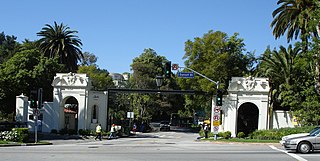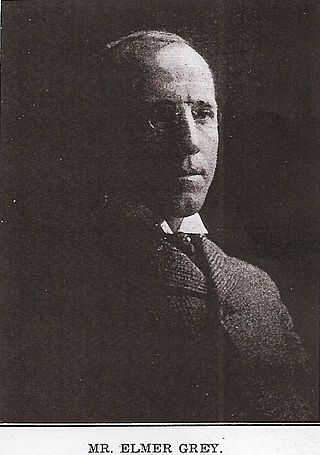
The Pacific Electric Railway Company, nicknamed the Red Cars, was a privately owned mass transit system in Southern California consisting of electrically powered streetcars, interurban cars, and buses and was the largest electric railway system in the world in the 1920s. Organized around the city centers of Los Angeles and San Bernardino, it connected cities in Los Angeles County, Orange County, San Bernardino County and Riverside County.

Bel Air is a residential neighborhood on the Los Angeles Westside, in the foothills of the Santa Monica Mountains in the U.S. state of California.

Los Angeles Union Station is the main train station in Los Angeles, California, and the largest passenger rail terminal in the Western United States. It opened in May 1939 as the Los Angeles Union Passenger Terminal, replacing La Grande Station and Central Station.

A crest is a component of a heraldic display, consisting of the device borne on top of the helm. Originating in the decorative sculptures worn by knights in tournaments and, to a lesser extent, battles, crests became solely pictorial after the 16th century.

Big Blue Bus is a public transit agency that provides public bus services for the city of Santa Monica and the greater Westside region of Los Angeles County, California. The service, operated by the city of Santa Monica, was founded on April 14, 1928 and throughout its existence has used a blue color scheme for its buses, leading to the Big Blue Bus nickname that would later become the official name of the agency. In 2023, the system had a ridership of 8,289,600, or about 27,500 per weekday as of the second quarter of 2024. Big Blue Bus receives funding from the Los Angeles County Metropolitan Transportation Authority (Metro) and offers connections to its Metro Bus and Metro Rail systems, but is operated independently from Metro.

Mid City is a neighborhood in Central Los Angeles, California.

Twist-on wire connectors are a type of electrical connector used to fasten two or more low-voltage electrical conductors. They are widely used in North America and several European countries in residential, commercial and industrial building power wiring, but have been banned in some other jurisdictions.
Life Alert Emergency Response, Inc., known as life alert, is a nationwide American device service company, with headquarters in Encino, California, USA, which provides services that help young and old elderly people contact emergency services. The company was founded in 1987. The company's system consists of a main unit and a small wireless help button that is worn by the user at all times. Former Surgeon General C. Everett Koop appeared in commercials for Life Alert starting in 1992, stating that he used one. He remained a spokesman for the company until his death in 2013.
The San Gabriel Valley Transit Authority (SGVTA) was a small quasi-governmental, public interest corporation operating as a bus transit provider in Los Angeles County, California providing free transport services to seniors, poor and disabled members of the cities of Monrovia and Sierra Madre. The SGVTA entered into a Memoranda of Understanding (MOU) with the two cities. Its equipment consisted primarily of five lift-equipped coaches and a 50 passenger bus. Its paid staff included fewer than a dozen coach and bus drivers.

The Solana Beach Transit Center is a train station on Amtrak California's Pacific Surfliner passenger train and on North County Transit District's COASTER commuter rail route located in Solana Beach, California. The tracks were lowered to their current position in the late 90s, to alleviate congestion on Lomas Santa Fe Road and Downtown Solana Beach. There are two tracks that carry the Surf Line in a trench through the city of Solana Beach, including the station.

California's transportation system is complex and dynamic. Although known for its car culture and extensive network of freeways and roads, the state also has a vast array of rail, sea, and air transport. Several subway, light rail, and commuter rail networks are found in many of the state's largest population centers. In addition, with the state's location on the West Coast of the United States, several important ports in California handle freight shipments from the Pacific Rim and beyond. A number of airports are also spread out across the state, ranging from small general aviation airports to large international hubs like Los Angeles International Airport and San Francisco International Airport.

The Los Angeles County Metropolitan Transportation Authority operates a vast fleet of buses for its Metro Bus and Metro Busway services. As of September 2019, Metro has the third largest bus fleet in North America with 2,320 buses.
Holmby Hills is a neighborhood on the Westside of Los Angeles, California, United States.

Elmer Grey, FAIA was an American architect and artist based in Pasadena, California. Grey designed many noted landmarks in Southern California, including the Beverly Hills Hotel, the Huntington Art Gallery, the Pasadena Playhouse and Wattles Mansion. He is credited with being one of the pioneers in the development of the new American architecture in the early 20th century, with a focus on harmony with nature and eliminating features not belonging to the local climate and conditions. Grey was also a noted artist whose paintings are in the permanent collection of the Chicago Art Institute.

Jeffrey Jonathon Hyland was an American real estate businessman, president of Hilton and Hyland, a real estate firm in Beverly Hills, California, and author. He had personally handled several billion dollars in real estate sales.
The S-1 Gard is a safety device consisting of a curved polyurethane guard, mounted in front of the right rear wheels of transit buses, designed to deflect a person out of the path of the wheels in order to prevent injury or death. It is distributed by Public Transportation Safety International (PTS) and is currently installed on bus fleets in major cities such as Los Angeles, Washington, D.C., Chicago, Austin (TX) and Baltimore, among others. The S-1 Gard was invented by Mark B. Barron of PTS in 1994.
A hypothermia cap is a therapeutic device used to cool the human scalp. Its most prominent medical applications are in preventing or reducing alopecia in chemotherapy, and for preventing cerebral palsy in babies born with neonatal encephalopathy caused by hypoxic-ischemic encephalopathy (HIE). It can also be used to provide neuroprotection after cardiac arrest, to inhibit stroke paralysis, and as cryotherapy for migraine headaches.

The MDZ Shield is a safety device for school buses, consisting of a two-piece polyurethane guard that encloses the upper wheel well opening and covers the gap in front of the right rear wheels, designed to deflect a person out of the path of the wheels in order to prevent injury or death. The "danger zone," which the shield acts to mitigate, refers to the area extending 10 feet to the front, rear and sides of the school bus, where children are at most risk of being hit by passing vehicles or by their own bus. Invented and developed by Mark B. Barron of Public Transportation Safety International, developer of the similar S-1 Gard for transit buses, and distributed by The C.E. White Company, the MDZ Shield first came to market in 2011.

A self-balancing scooter is a self-balancing personal transporter consisting of two motorized wheels connected to a pair of articulated pads on which the rider places their feet. The rider controls the speed by leaning forward or backward, and direction of travel by twisting the pads.














